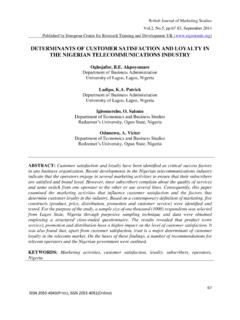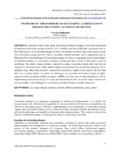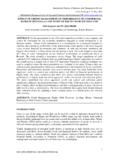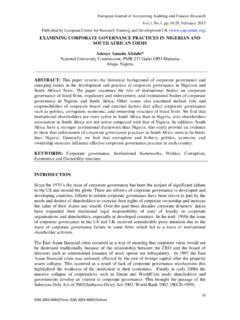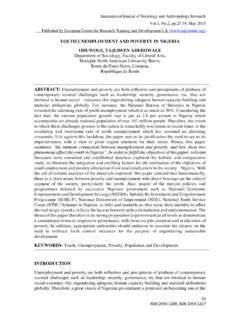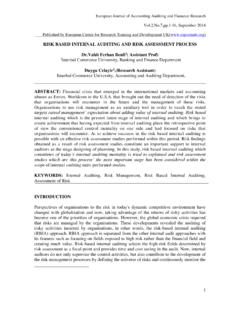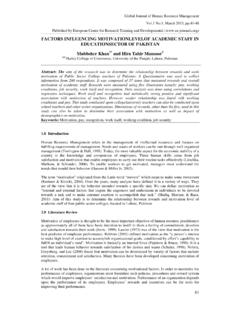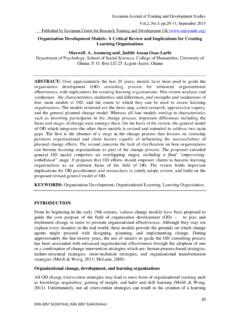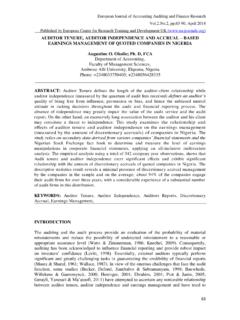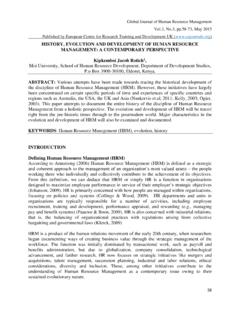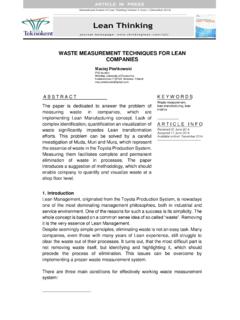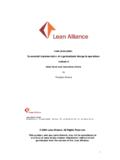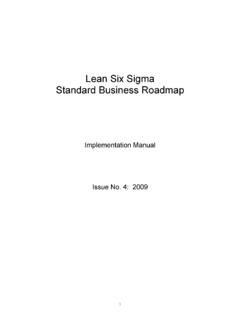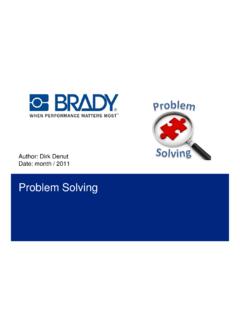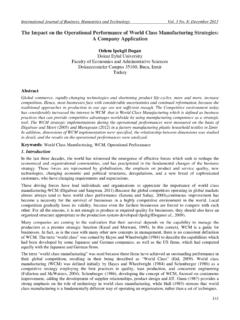Transcription of EFFECTS OF LEAN PRODUCTION ON …
1 European Journal of Logistics Purchasing and Supply Chain Management , , , June 2014 Published by European Centre for Research Training and Development UK ( ) 1 EFFECTS OF lean PRODUCTION ON ORGANIZATIONAL PERFORMANCE: A CASE STUDY OF FLOUR PRODUCING COMPANY IN KENYA. Keitany, P.*1, Riwo-Abudho, 1 Jomo Kenyatta University of Agriculture & Technology, Kenya Box 16530-20100, Nakuru, Kenya. ABSTRACT: Global competition in business has forced most PRODUCTION sectors to realign their strategies to achieve competitive advantage. In flour producing companies in Kenya, the problem of broad PRODUCTION has been in place and as advanced technology takes its roots in Africa, there has been an increasing demand for quality output by the industry; which can be achieved by effective adoption of various PRODUCTION systems. The paper sought to assess the EFFECTS of lean PRODUCTION on organizational performance.
2 The study was designed determine the elements of lean PRODUCTION , effect of lean PRODUCTION systems on product quality, strategies for waste reduction and the challenges of adopting lean PRODUCTION . The study adopted a descriptive research design. Data The study found out improving management style and involving all employees at all levels, as well as better inventory management leads to a more efficient practice of lean PRODUCTION . Material management and physical distribution are positively related and are therefore critical determinants of successful lean PRODUCTION practice within the organization. With a response rate of 75% the study concluded firms should adopt the use of lean PRODUCTION system as a means to improved performance. KEYWORDS: Organizational Performance, lean PRODUCTION System, Total Quality Management, Just-In-Time, Inventory Management System.
3 INTRODUCTION Organizations can gain competitive advantage from lean PRODUCTION practices. Such practices enable the organization to get superior performance through reduction of wastes and other related costs (Ohno, 2008). Industries are nowadays facing a problem of broad PRODUCTION in their organizations thus resulting to lots of wastage. This has seen many companies experience problems of waste along the supply chain and the liability to make the right products for cutomer satisfaction. Procurement managers are bound to embrace the essence of adopting lean PRODUCTION which is a business initiative to reduce waste in manufacture PRODUCTION . To this extent therefore, this initiative leverage companies to achieve long term competitive advantages by putting in place the proper PRODUCTION systems and technologies particularly with regard to product quality, shortening product design time, the reducing of wastage improving end customer satisfaction and inventory management (Womack &Jones).
4 According to Bruce and Larco (1999), lean PRODUCTION is both a concept that can be viewed and implemented at a number of levels and also a commitment process of relentless improvement that can significantly impact upon an organizations health wealth and competitiveness. lean PRODUCTION can resolve severe organizational problems and be a powerful approach to gather and unite change initiatives that are running currently through a business. Traditionally, companies used broad PRODUCTION systems which made it difficult for them to improve on their productivity thus customer satisfaction (Bicheno, 2007). However for most companies, use of recent technologies for lean PRODUCTION system has become critical and is a standard practice for achieving greater performance gains (Emiliani, 2006). European Journal of Logistics Purchasing and Supply Chain Management , , , June 2014 Published by European Centre for Research Training and Development UK ( ) 2 The Concept of lean PRODUCTION lean PRODUCTION refers to a business model that emphasizes on meeting customers expectations by delivering quality products at the least cost when required.
5 The lean Aerospace Initiative (2002) has defined lean thinking as the dynamic, knowledge driven and customer focused process through which all people in a defined enterprise continuously eliminate waste with the goal of creating value. According to Bruce and Larco (1999) lean is both a concept that can be viewed and implemented at a number of level and also a commitment process of relentless improvement that can significantly impact upon an organizations health, wealth and competitiveness. James & Daniel (1996) states that lean can resolve severe organizational problems and additionally can be a powerful approach to gather and unite several change initiatives that are running through. Bicheno, (2007), claims that in batch PRODUCTION , about 98% of time activities is not value adding time.
6 In order to implement the concept of lean manufacturing successfully, many researchers emphasizes on commitment by top management (Alavi, 2003). Most organizations pursue lean in response to their need to fundamentally improve business competitiveness by reducing cost while increasing quality and customer responsiveness including meeting delivery time. According to Boyer & Sovilla, (2003), managers should also work to create interest in the implementation of lean . The business competitiveness needs can manifest through increase in direct global competition or from evolving customer or supply chain expectations. lean practitioners often acknowledge that successful lean implementation can require a real or perceived business crisis to justify or foster receptiveness to the significant transformation that lean requires to an organization culture and process.
7 Studies have been done to show the role of lean PRODUCTION system. According to a case study of Kodak Canada Inc., Kodak s Director of Global Manufacturing and Logistics, Charlie Brown steered the company towards adopting lean productions in 1998, by adopting Kodak Operating System (KOS). lean therefore has not only improved procedure, reduced inventory and enhanced ergonomics, but it allows the company to fine-tune its chemistry and keep pace with changes in demand . lean Manufacturing Management and Competitive Skills The driving force behind lean PRODUCTION is the essence of creating substantial performance. The drawing force behind lean PRODUCTION is the essence of creating substantial value with the purpose of utilizing resources to their best advantage. It is imperative to note that lean PRODUCTION can only be realized in an environment which its top level management of the firm/ company invariability support its implementation.
8 Such abrupt policy changes require a top-down approach to decision making (Kobayashi, 1995). Boyer, (1996) stated the successful implementation of lean PRODUCTION relies on well-trained employees. In a lean PRODUCTION environment, training is pivotal in order to develop a workforce, which is capable of shouldering the increased responsibilities, to develop multi-skilled workers, and to create an environment in which workers have the skills and ability to push for continuous improvement. In reference to Womack, et al. (1990), Boyer concluded that plants which allocate greater resources for the training of the workforce have been shown to have increased productivity. Forrester, (1995) stated that lean manufacturing is usually accompanied by a shift towards exposure and problem solving. This changes calls for a new approach in problem solving.
9 Boyer, (1996) mentioned that teamwork and group problem solving is a critical component of TQM and JIT. In tandem, teamwork and group problem solving serve to crash barriers and to improve the flow of information through a company, thus leading to improved productivity. Working as groups, while utilizing appropriate problem solving techniques, will also increase efficiency and pride in work improvement European Journal of Logistics Purchasing and Supply Chain Management , , , June 2014 Published by European Centre for Research Training and Development UK ( ) 3 outputs (Gatchalian, 1997).The design of a lean manufacturing system depends on attributes that may influence the behaviour of the buyer. According to Chase, Jacobs and Aquilano (2006), different clients are attracted by different attributes.
10 For example some customers are more sensitive to the price of a product or service and therefore companies emphasize on cost reduction. Skills applied to competitive business strategies can be presented in different perspectives or dimensions for instance, those based on resources (Wernerfelt, 1984), on dynamic capabilities (Teece et al., 1997), on business relationships (Dyer & Singh, 1998), on essential characteristics (Hamel & Prahalad, 1995) or on competitive priorities. The seven wastes and lead time reduction The basic idea to reach a desirable state is the principle of using Kaizen or continuous improvement to reduce waste. According to Shingo (1989) waste is any activity that does not contribute to operations and there with does not contribute to operations and there with unpacking supplied parts or waiting for lots to be finished.
